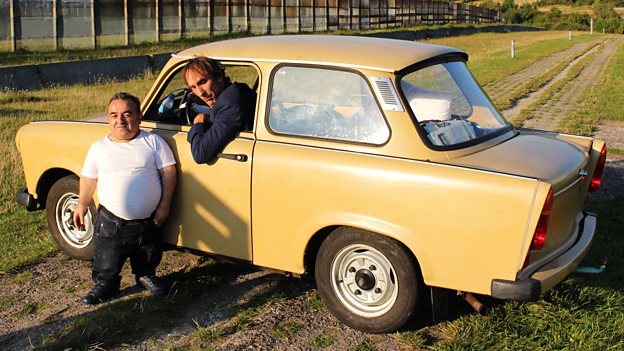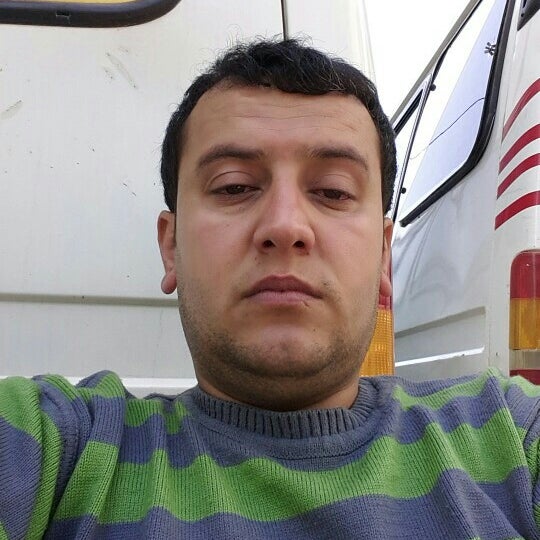You are using an out of date browser. It may not display this or other websites correctly.
You should upgrade or use an alternative browser.
You should upgrade or use an alternative browser.
(early) STASILAND Character sheets/Character ideas
- Thread starter lazy grouch
- Start date
the last man
corn lord
- Joined
- Nov 30, 2016
- Messages
- 4,831
- Nebulae
- 24,736
i dont know how limited it will be with auths or whatever but i really just want to play a depressed ddr ex-english-teacher who tries to hide and smuggle censored books, dodging stasi
Reactions:
List
dallahan
a bad memer
- Joined
- Apr 26, 2016
- Messages
- 15,071
- Nebulae
- 28,722
nuh Officer, don' take my KNOWLEDGE!i dont know how limited it will be with auths or whatever but i really just want to play a depressed ddr ex-english-teacher who tries to hide and smuggle censored books, dodging stasi
Reactions:
List
the last man
corn lord
- Joined
- Nov 30, 2016
- Messages
- 4,831
- Nebulae
- 24,736
nuh Officer, don' take my KNOWLEDGE!
Here in my Garage, just bought this new Trabant here
but you know what i like a lot more than my deutsche Mark?
WISSEN
Reactions:
List
the last man
corn lord
- Joined
- Nov 30, 2016
- Messages
- 4,831
- Nebulae
- 24,736
Offizier, es ist ein Buch auf Englisch, einem Handbuch zum sowjetisch schwanzlutschen, es mag dir passen, vielleichtplease nein officer
ich need my wissen, its very important to mein hirn, bITTE!
ich habe es bei Aldi gekauft
Reactions:
List
Black Rain (1989)
The Rise and Fall of Ziggy Chardust
- Joined
- Apr 26, 2016
- Messages
- 4,891
- Nebulae
- 34,067
Offizier, es ist ein Buch auf Englisch, einem Handbuch zum sowjetisch schwanzlutschen, es mag dir passen, vielleicht
ich habe es bei Aldi gekauft
wir kaufen alle bei
A L D I
Reactions:
List
dallahan
a bad memer
- Joined
- Apr 26, 2016
- Messages
- 15,071
- Nebulae
- 28,722
bei Aldi?!Offizier, es ist ein Buch auf Englisch, einem Handbuch zum sowjetisch schwanzlutschen, es mag dir passen, vielleicht
ich habe es bei Aldi gekauft
das ist Verrat! Sowas möchte ich hier in meinem Land nie wieder sehen! Sie widerwärtiger verräter!
Reactions:
List
the last man
corn lord
- Joined
- Nov 30, 2016
- Messages
- 4,831
- Nebulae
- 24,736
bei Aldi?!
das ist Verrat! Sowas möchte ich hier in meinem Land nie wieder sehen! Sie widerwärtiger verräter!
Offizier du verstehst nichts, es ist einer Verkauf-ulotion in Deutschland! Jeden Tag kaufe ich billig Fleisch, Brot und Milch!
WIR KAUFEN ALLE BEI
ALDI
Reactions:
List
dallahan
a bad memer
- Joined
- Apr 26, 2016
- Messages
- 15,071
- Nebulae
- 28,722
A L D IOFFIZIER DU VERSTEHST NICHTS, ES IST EINER VERKAUF-ULOTION IN DEUTSCHLAND, JEDEN TAG KAUFE ICH BILLIG FLEISCH, BROT UND MILCH
Offizier du verstehst nichts, es ist einer Verkauf-ulotion in Deutschland! Jeden Tag kaufe ich billig Fleisch, Brot und Milch!
WIR KAUFEN ALLE BEI
ALDI
Reactions:
List
bubblegum
you should see me in a crown
- Joined
- Jun 21, 2016
- Messages
- 6,973
- Nebulae
- 13,177
D
Deleted member 243
Guest
Bandit
Nucleus
- Joined
- Jun 27, 2016
- Messages
- 1,193
- Nebulae
- 1,303
Black Rain (1989)
The Rise and Fall of Ziggy Chardust
- Joined
- Apr 26, 2016
- Messages
- 4,891
- Nebulae
- 34,067
7th Mechanized Division
79th Guards Bobruisk Tank Regiment
3rd Shock Army
Group of Soviet Forces in Germany (ГСВГ)
Dessau-Rosslau
Instructions manual on field specializations and assigned roles
Last updated: 19-3-1991
Commissioned by the Bureau for the Group of Soviet Forces in Germany (ΓCΒΓ)
Specialisations can be split into two different categories;
Active Combat Specialisations
Passive Specialisations
ACTIVE COMBAT SPECIALISATIONS
Active Combat Specialisations consist of roles that focus on in-combat operations, as opposed to passive roles that help in general situations. They consist of the following;
RIFLEMAN
The rifleman is the bog-standard backbone of the armed forces, their training and equipment are rather uniform, and remain unchanging unless given a specific specialisation. Their equipment consists of , but is not limited to, the following;
AK-74
The AK-74 is an assault rifle developed in the early 1970s as the replacement for the earlier AKM. It uses a smaller 5.45×39mm cartridge, replacing the 7.62×39mm chambering of earlier Kalashnikov-pattern weapons.

RGD-5
The RGD-5 (Ruchnaya Granata Distantsionnaya, English "Hand Grenade Remote"), is a post-World War II Soviet anti-personnel fragmentation grenade, designed in the early 1950s. RGD-5 was accepted to service in 1954. It is still in service with many of Russia's former client states and has been supplied to Iraq as well as other Arab nations. It weighs 310 grams (11 oz). Its 117 millimetres (4.6 in) in length and 58 millimetres (2.3 in) in diameter. The RGD-5 can also be mounted onto the front of the AK-74 using a cup-type grenade launcher.
RD-54
The RD-54 backpack/load bearing system is the main system used by the Soviet Armed Forces Infantry, consisting of a main knapsack and two additional pouches connected to a belt system, alongside a single entrenching tool (Though the loadout of the RD-54 can be modified accordingly).
6B2
This army flak jacket of the first generation. He is the first massive army bulletproof vest in the Soviet army. Developed in the USSR "Research Institute of Steel" in late 1978. Was adopted to supply the CA in 1979. Widely used in the war in Afghanistan.
6B2 consists of chest and back parts connected with each other in the shoulder joints and with the side buckles. Protective composition consists of titanium armor plates ADU-605-80 1.25 mm thick and ballistic screen of 30 layers of aramid fabric TSVM-G.
Lifchik Version 1
The “Lifchik” load bearing vest is a simple contraption, made for holding several AK magazines, and up to four grenades or other miscellaneous equipment. Held together with some straps and buckles, the vest is easy to maintain and repair.
SSh68
The SSh-68, Russian: СШ-68 (стальной шлем образца 1968 года/stalnoy shlyem, or steel helmet) (English: SSh-68 steel helmet model 1968) - is a combat steel combat helmet of the Soviet Armed Forces. The SSh-68 is further development of combined-arms helmet SSh-60. It differs primarily in its greater strength, greater front slope of the dome and the shorter outer edge. It is usually painted in dark green. SSh-68 provides protection from impact shock (machetes, etc.), and steel fragments weighing 1.0 grams at speeds up to 250 m/s. The SSh-68 is not meant to protect against bullets.
HEAVY WEAPONS
Heavily armed and heavily armoured, these support soldiers supply much needed firepower and support to their comrades.
RPK
The 7.62mm Kalashnikov modernised (light machine gun) is designed to engage enemy manpower and fire weapons. The machine gun has an iron sight and provision is made to install an optical or night sight. In addition, it is fitted with a bipod and a folding stock which provide a quick and convenient changeover from travelling to fire position and back.

Ammo boxes
The ammo boxes are a vital part of every light machine gunners arsenal, proving to be the main form of carrying munitions whilst on a patrol, due to the inefficiency and issues that come with ammo belts. Usually these boxes are carried by a designated ammo-bearer, rather than on the gunner themselves.
RPG-7
The RPG-7 (Russian: РПГ-7) is a portable, reusable, unguided, shoulder-launched, anti-tank rocket-propelled grenade launcher. Originally the RPG-7 (Ручной Противотанковый Гранатомёт – Ruchnoy Protivotankoviy Granatomyot – Hand-held anti-tank grenade launcher) and its predecessor, the RPG-2, were designed by the Soviet Union. The ruggedness, simplicity, low cost, and effectiveness of the RPG-7 has made it the most widely used anti-armour weapon in the world. Currently around 40 countries use the weapon, and it is manufactured in several variants by nine countries. It is popular with irregular and guerrilla forces.
BHI RPG Rocket Quiver
The rocket quiver acts as a storage compartment for RPG-7 warheads, storing up to three at a time. Primarily made from canvas material, the quiver is not waterproof, but is wind resistant, and specially suited to hold the full size of three RPG warheads without issue.
ASSAULT PIONEER
The Assault Pioneers are not only experts in construction, but demolition. Armed with various tools and equipment for building entrenchments and flushing enemy combatants out of theirs, they are a vital part of any fire team.
‘Molniya’
These devices are usually otherwise regarded as explosive traps, they can range from anything from IEDs, to tripwires, to more destructive devices. They can usually be assembled using various other components, such as mortar shells and landmines.
PFM-1
PFM-1 (Russian: ПФМ-1, short for противопехотная фугасная мина - anti-infantry high-explosive mine; NATO name: Green parrot, also known as butterfly mine) is a land mine of Soviet production, very similar to the BLU-43 US Army landmine. Both devices are very similar in shape and principles, although they use different explosives. The mine is, in essence, a plastic container containing explosive liquid. The mine is stored with a pin restraining a detonating plunger. Once the arming pin is removed, the plunger is slowly forced forward by a spring until it contacts the detonator, at which point it is armed. This takes between one and forty minutes, allowing the mine to be deployed manually, or air dropped.
TM-46
The TM-46 mine is a large, circular, metal-cased Soviet anti-tank mine. It uses either a pressure fuze or tilt-rod, which is screwed into the top. Anti-tank mines with this type of fuse were capable of inflicting much more damage to armoured vehicles.
LPO-50
Developed in 1953 to replace the ROKS-2/3 flamethrowers used during World War Two, it was kept in the inventory well into the 1980s. This model was designed as a lightweight, manpack flamethrower with three upright cylinders and a bipod-mounted flame gun. It differed from Western flamethrowers in that it used special ignition cartridges to expel the thickened fuel mixture rather than an inert gas.
COMBAT LIFE SAVER
The combat life saver, otherwise known as the ‘medic’, is equipped with the same equipment as a standard rifleman, with some minor adjustments. They are given a rucksack filled with medical equipment, ranging from surgical equipment to basic first aid supplies. Due to this change in equipment, they need to facilitate their weapons accordingly, usually being issued smaller firearms such as an AKS74u, or SR-1 Kozyr.

AKS-74u
The AKS-74 ("S"—Russian: складной; Skladnoy, or "folding"), is a variant of the AK-74 equipped with a side-folding metal shoulder stock, designed primarily for use with air assault infantry and developed alongside the basic AK-74. Unlike the AKMS's somewhat fragile underfolding stock (modelled after the MP 40 sub machine gun stock), the AKS-74 stock is fabricated from stamped sheet metal struts, machine pressed into a "U" shape and assembled by punch fit and welding.
SCOUT

Lightly armoured and equipped with binoculars, flares and long-range rifles (or assault rifles augmented with long range scopes), scouts are primarily reserved to operating in smaller squads performing reconnaissance on enemy fortifications and positions, relaying information back to assault squads. Scouts may also be assigned to provide long range supporting fire, as well as coordinated strikes against enemy HVTs.
PASSIVE ASSIGNMENTS
CREWMAN
The crewman is equipped with an AKSu-74 utility rifle, giving them more flexibility outside of their vehicles. The crewman can assume many roles within’ a vehicle; commander, gunner, driver and loader are few amongst them. The crewman is primarily tasked with driving and protecting logistics trucks throughout the AO, making sure they reach their destination. The crewman is also trained in the use of several combat vehicles such as the T80-U MBT and the BTR APC series. They are usually provided with the necessary knowledge in the field of repairs.
Makarov PM

The Makarov pistol or PM (Russian: Пистолет Макарова, Pistolet Makarova, literally Makarov's Pistol) is a Russian semi-automatic pistol. Under the project leadership of Nikolay Fyodorovich Makarov, it became the Soviet Union's standard military and police side arm in 1951
GP-5 Mask
The GP-5 gas mask (Russian: Гражда́нский Противога́з-5, tr. Grazhdanskiy Protivogaz-5) is a Soviet-made single-filter gas mask. It was issued to the Soviet population starting in 1962; production ended in 1990. It is a lightweight mask, weighing 1.09 kg (2.42 lbs). It can operate in all weather and withstand temperatures from −40 degrees (Celsius and Fahrenheit) to 114 °C (237 °F). The GP-5 also comes with sealed glass eye pieces. They were originally made to protect the wearer from radioactive fallout.
SQUAD LEADER
The squad leader (SL), as the name may suggest, leads a squadron of men both in battle, and on-duty in general. They may be assigned for the duration of a full operation, or simply for the duration of a patrol, depending on circumstances. The squad leader is expected to be well versed in strategy and security operations, as to not risk the lives of their men unnecessarily, or to compromise on-going operations. This being said, the squad leader is typically the most important individual in a squadron, excluding any possible government officials accompanying them or commissioned officers.
SECOND IN COMMAND
Like the squad leader, the second in command (2IC or SIC) coordinates and leads their men in battle and on-duty. They typically help the squad leader with their tasks, and act as a symbol of authority in the squad. If the squad leader were to fall in the line of combat, this individual would take over and continue the operation, or call the squad back to the nearest outpost or forward operating base.
ARTILLERYMAN
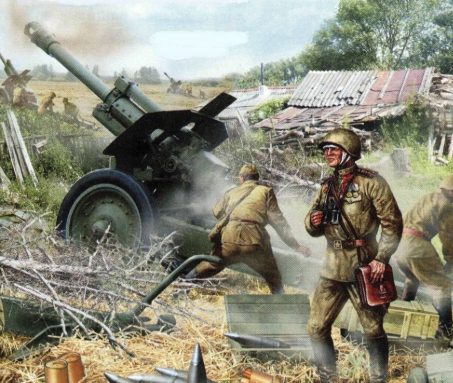
Tasked with the management and deployment of the regiment's artillery, artillerymen work in close co-ordination with NCOs and COs, as well as scouts - using their heavy ordinance to strike fortified enemy positions. Their weaponry consists of everything from self-propelled rocket artillery, heavy howitzers, to even heavy calibre machine guns and mortars.
Artillerymen are also expected to work closely with assault pioneers in building fortifications, being sure to deploy anti-tank weapons and other heavy weapons when appropriate. The artilleryman is expected to be well versed in which type of ammunition to use, the type of gun to use and how to use it when called upon by their commanding officer.
Written by @whiskers, @GenericPlayer
Editing & Additions by @char
All susceptible to edits and changes.
Feedback welcome. Happy to answer any questions regarding this new system.
Reactions:
List
TinPan
Needs to blow his nose
- Joined
- Apr 26, 2016
- Messages
- 2,746
- Nebulae
- 5,505
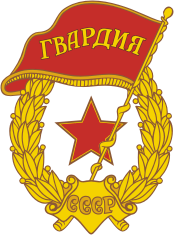
7th Mechanized Division
79th Guards Bobruisk Tank Regiment
3rd Shock Army
Group of Soviet Forces in Germany (ГСВГ)
Dessau-Rosslau
Instructions manual on field specializations and assigned roles
Last updated: 19-3-1991
Commissioned by the Bureau for the Group of Soviet Forces in Germany (ΓCΒΓ)

Specialisations can be split into two different categories;
Active Combat Specialisations
Passive Specialisations
ACTIVE COMBAT SPECIALISATIONS
Active Combat Specialisations consist of roles that focus on in-combat operations, as opposed to passive roles that help in general situations. They consist of the following;
RIFLEMAN

The rifleman is the bog-standard backbone of the armed forces, their training and equipment are rather uniform, and remain unchanging unless given a specific specialisation. Their equipment consists of , but is not limited to, the following;
AK-74
The AK-74 is an assault rifle developed in the early 1970s as the replacement for the earlier AKM. It uses a smaller 5.45×39mm cartridge, replacing the 7.62×39mm chambering of earlier Kalashnikov-pattern weapons.

RGD-5
The RGD-5 (Ruchnaya Granata Distantsionnaya, English "Hand Grenade Remote"), is a post-World War II Soviet anti-personnel fragmentation grenade, designed in the early 1950s. RGD-5 was accepted to service in 1954. It is still in service with many of Russia's former client states and has been supplied to Iraq as well as other Arab nations. It weighs 310 grams (11 oz). Its 117 millimetres (4.6 in) in length and 58 millimetres (2.3 in) in diameter. The RGD-5 can also be mounted onto the front of the AK-74 using a cup-type grenade launcher.
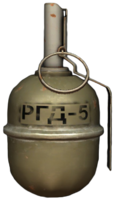
RD-54
The RD-54 backpack/load bearing system is the main system used by the Soviet Armed Forces Infantry, consisting of a main knapsack and two additional pouches connected to a belt system, alongside a single entrenching tool (Though the loadout of the RD-54 can be modified accordingly).

6B2
This army flak jacket of the first generation. He is the first massive army bulletproof vest in the Soviet army. Developed in the USSR "Research Institute of Steel" in late 1978. Was adopted to supply the CA in 1979. Widely used in the war in Afghanistan.
6B2 consists of chest and back parts connected with each other in the shoulder joints and with the side buckles. Protective composition consists of titanium armor plates ADU-605-80 1.25 mm thick and ballistic screen of 30 layers of aramid fabric TSVM-G.
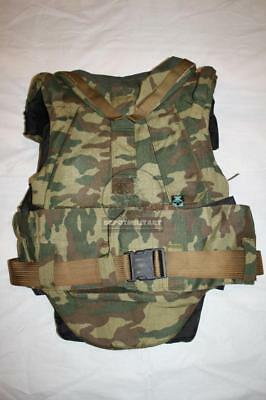
Lifchik Version 1
The “Lifchik” load bearing vest is a simple contraption, made for holding several AK magazines, and up to four grenades or other miscellaneous equipment. Held together with some straps and buckles, the vest is easy to maintain and repair.
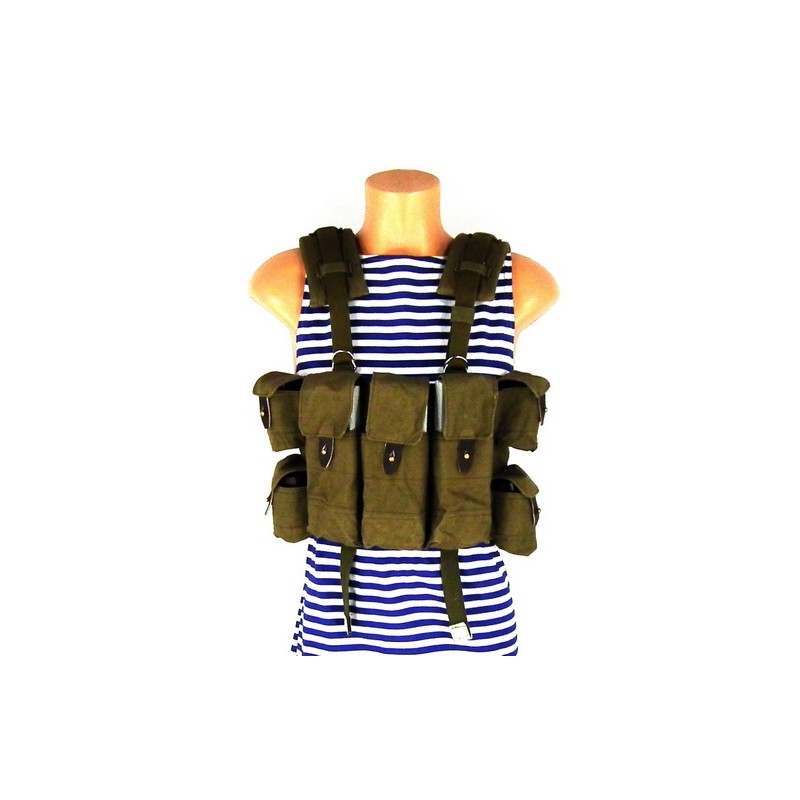
SSh68
The SSh-68, Russian: СШ-68 (стальной шлем образца 1968 года/stalnoy shlyem, or steel helmet) (English: SSh-68 steel helmet model 1968) - is a combat steel combat helmet of the Soviet Armed Forces. The SSh-68 is further development of combined-arms helmet SSh-60. It differs primarily in its greater strength, greater front slope of the dome and the shorter outer edge. It is usually painted in dark green. SSh-68 provides protection from impact shock (machetes, etc.), and steel fragments weighing 1.0 grams at speeds up to 250 m/s. The SSh-68 is not meant to protect against bullets.

HEAVY WEAPONS
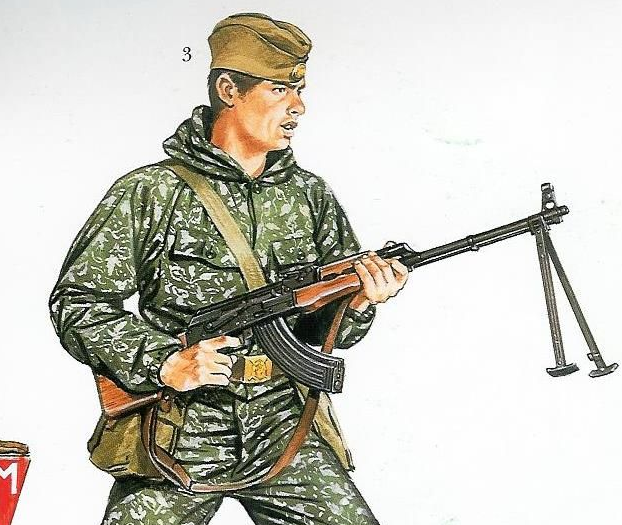
Heavily armed and heavily armoured, these support soldiers supply much needed firepower and support to their comrades.
RPK
The 7.62mm Kalashnikov modernised (light machine gun) is designed to engage enemy manpower and fire weapons. The machine gun has an iron sight and provision is made to install an optical or night sight. In addition, it is fitted with a bipod and a folding stock which provide a quick and convenient changeover from travelling to fire position and back.

Ammo boxes
The ammo boxes are a vital part of every light machine gunners arsenal, proving to be the main form of carrying munitions whilst on a patrol, due to the inefficiency and issues that come with ammo belts. Usually these boxes are carried by a designated ammo-bearer, rather than on the gunner themselves.
RPG-7
The RPG-7 (Russian: РПГ-7) is a portable, reusable, unguided, shoulder-launched, anti-tank rocket-propelled grenade launcher. Originally the RPG-7 (Ручной Противотанковый Гранатомёт – Ruchnoy Protivotankoviy Granatomyot – Hand-held anti-tank grenade launcher) and its predecessor, the RPG-2, were designed by the Soviet Union. The ruggedness, simplicity, low cost, and effectiveness of the RPG-7 has made it the most widely used anti-armour weapon in the world. Currently around 40 countries use the weapon, and it is manufactured in several variants by nine countries. It is popular with irregular and guerrilla forces.
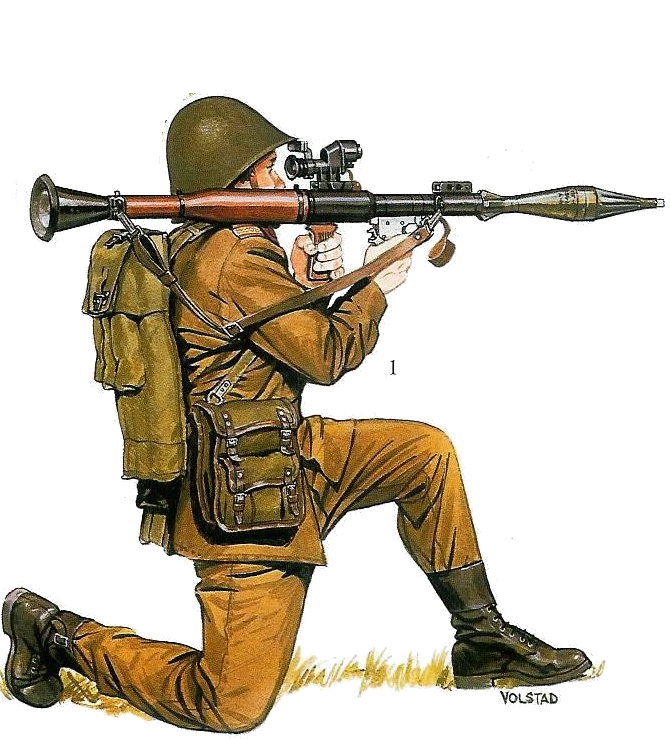
BHI RPG Rocket Quiver
The rocket quiver acts as a storage compartment for RPG-7 warheads, storing up to three at a time. Primarily made from canvas material, the quiver is not waterproof, but is wind resistant, and specially suited to hold the full size of three RPG warheads without issue.
ASSAULT PIONEER

The Assault Pioneers are not only experts in construction, but demolition. Armed with various tools and equipment for building entrenchments and flushing enemy combatants out of theirs, they are a vital part of any fire team.
‘Molniya’
These devices are usually otherwise regarded as explosive traps, they can range from anything from IEDs, to tripwires, to more destructive devices. They can usually be assembled using various other components, such as mortar shells and landmines.
PFM-1
PFM-1 (Russian: ПФМ-1, short for противопехотная фугасная мина - anti-infantry high-explosive mine; NATO name: Green parrot, also known as butterfly mine) is a land mine of Soviet production, very similar to the BLU-43 US Army landmine. Both devices are very similar in shape and principles, although they use different explosives. The mine is, in essence, a plastic container containing explosive liquid. The mine is stored with a pin restraining a detonating plunger. Once the arming pin is removed, the plunger is slowly forced forward by a spring until it contacts the detonator, at which point it is armed. This takes between one and forty minutes, allowing the mine to be deployed manually, or air dropped.
TM-46
The TM-46 mine is a large, circular, metal-cased Soviet anti-tank mine. It uses either a pressure fuze or tilt-rod, which is screwed into the top. Anti-tank mines with this type of fuse were capable of inflicting much more damage to armoured vehicles.
LPO-50
Developed in 1953 to replace the ROKS-2/3 flamethrowers used during World War Two, it was kept in the inventory well into the 1980s. This model was designed as a lightweight, manpack flamethrower with three upright cylinders and a bipod-mounted flame gun. It differed from Western flamethrowers in that it used special ignition cartridges to expel the thickened fuel mixture rather than an inert gas.
COMBAT LIFE SAVER
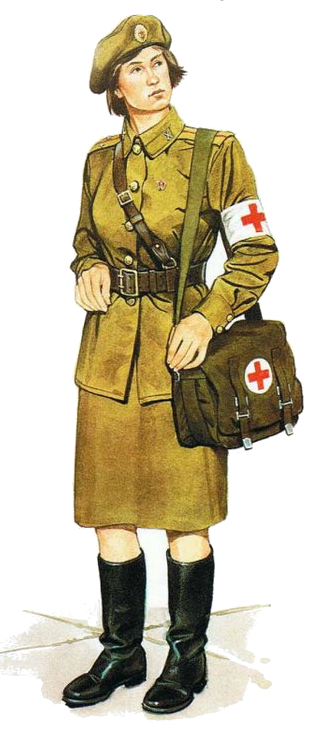
The combat life saver, otherwise known as the ‘medic’, is equipped with the same equipment as a standard rifleman, with some minor adjustments. They are given a rucksack filled with medical equipment, ranging from surgical equipment to basic first aid supplies. Due to this change in equipment, they need to facilitate their weapons accordingly, usually being issued smaller firearms such as an AKS74u, or SR-1 Kozyr.

AKS-74u
The AKS-74 ("S"—Russian: складной; Skladnoy, or "folding"), is a variant of the AK-74 equipped with a side-folding metal shoulder stock, designed primarily for use with air assault infantry and developed alongside the basic AK-74. Unlike the AKMS's somewhat fragile underfolding stock (modelled after the MP 40 sub machine gun stock), the AKS-74 stock is fabricated from stamped sheet metal struts, machine pressed into a "U" shape and assembled by punch fit and welding.
SCOUT

Lightly armoured and equipped with binoculars, flares and long-range rifles (or assault rifles augmented with long range scopes), scouts are primarily reserved to operating in smaller squads performing reconnaissance on enemy fortifications and positions, relaying information back to assault squads. Scouts may also be assigned to provide long range supporting fire, as well as coordinated strikes against enemy HVTs.
PASSIVE ASSIGNMENTS
CREWMAN
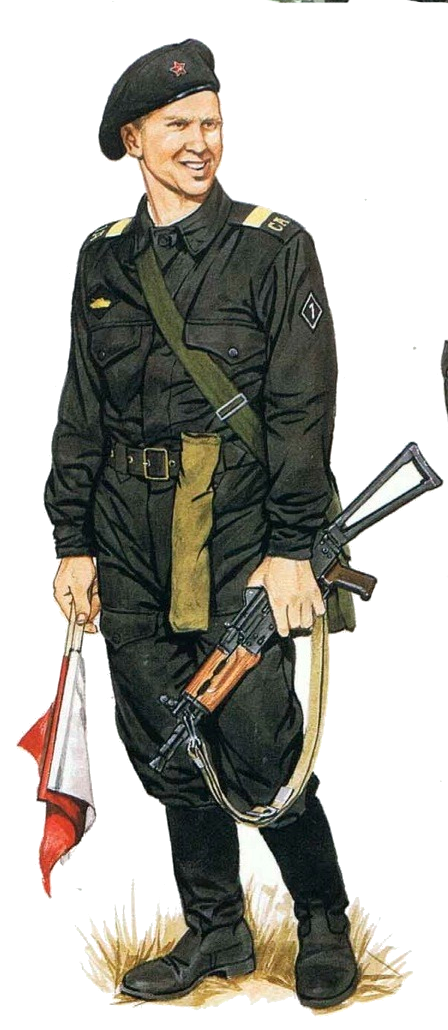
The crewman is equipped with an AKSu-74 utility rifle, giving them more flexibility outside of their vehicles. The crewman can assume many roles within’ a vehicle; commander, gunner, driver and loader are few amongst them. The crewman is primarily tasked with driving and protecting logistics trucks throughout the AO, making sure they reach their destination. The crewman is also trained in the use of several combat vehicles such as the T80-U MBT and the BTR APC series. They are usually provided with the necessary knowledge in the field of repairs.
Makarov PM

The Makarov pistol or PM (Russian: Пистолет Макарова, Pistolet Makarova, literally Makarov's Pistol) is a Russian semi-automatic pistol. Under the project leadership of Nikolay Fyodorovich Makarov, it became the Soviet Union's standard military and police side arm in 1951
GP-5 Mask
The GP-5 gas mask (Russian: Гражда́нский Противога́з-5, tr. Grazhdanskiy Protivogaz-5) is a Soviet-made single-filter gas mask. It was issued to the Soviet population starting in 1962; production ended in 1990. It is a lightweight mask, weighing 1.09 kg (2.42 lbs). It can operate in all weather and withstand temperatures from −40 degrees (Celsius and Fahrenheit) to 114 °C (237 °F). The GP-5 also comes with sealed glass eye pieces. They were originally made to protect the wearer from radioactive fallout.
SQUAD LEADER
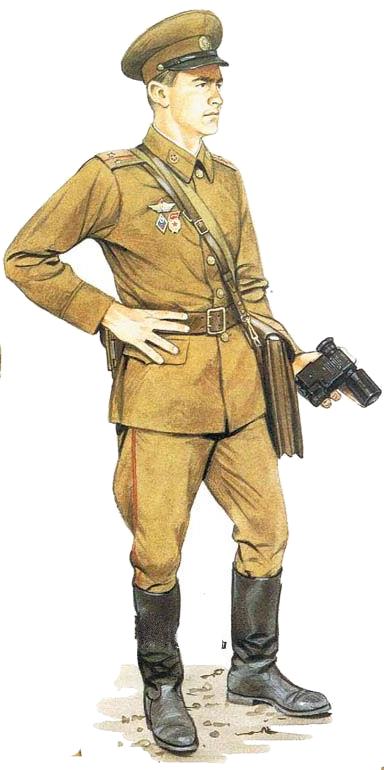
The squad leader (SL), as the name may suggest, leads a squadron of men both in battle, and on-duty in general. They may be assigned for the duration of a full operation, or simply for the duration of a patrol, depending on circumstances. The squad leader is expected to be well versed in strategy and security operations, as to not risk the lives of their men unnecessarily, or to compromise on-going operations. This being said, the squad leader is typically the most important individual in a squadron, excluding any possible government officials accompanying them or commissioned officers.
SECOND IN COMMAND
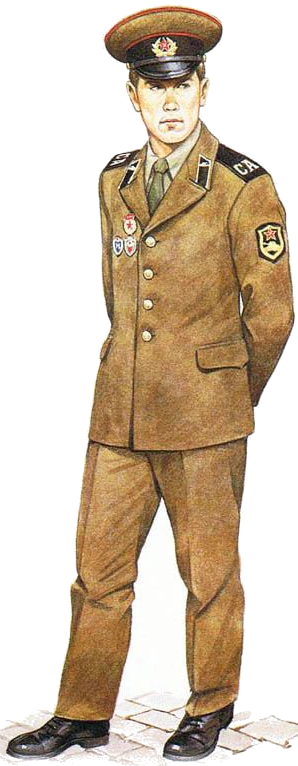
Like the squad leader, the second in command (2IC or SIC) coordinates and leads their men in battle and on-duty. They typically help the squad leader with their tasks, and act as a symbol of authority in the squad. If the squad leader were to fall in the line of combat, this individual would take over and continue the operation, or call the squad back to the nearest outpost or forward operating base.
ARTILLERYMAN

Tasked with the management and deployment of the regiment's artillery, artillerymen work in close co-ordination with NCOs and COs, as well as scouts - using their heavy ordinance to strike fortified enemy positions. Their weaponry consists of everything from self-propelled rocket artillery, heavy howitzers, to even heavy calibre machine guns and mortars.
Artillerymen are also expected to work closely with assault pioneers in building fortifications, being sure to deploy anti-tank weapons and other heavy weapons when appropriate. The artilleryman is expected to be well versed in which type of ammunition to use, the type of gun to use and how to use it when called upon by their commanding officer.

Written by @whiskers, @GenericPlayer
Editing & Additions by @char
All susceptible to edits and changes.
Feedback welcome. Happy to answer any questions regarding this new system.

In all seriousness though, it’s very nice to see the progress made so far and reading through written stuff like this always helps to give people ideas about what capabilities the Soviet's will be having; looking forward to what else gets written up in regards to stuff like Stasi capabilities & equiptment.
Reactions:
List
Rabid
Rictal-Approved
- Joined
- Apr 26, 2016
- Messages
- 39,308
- Nebulae
- 109,797

7th Mechanized Division
79th Guards Bobruisk Tank Regiment
3rd Shock Army
Group of Soviet Forces in Germany (ГСВГ)
Dessau-Rosslau
Instructions manual on field specializations and assigned roles
Last updated: 19-3-1991
Commissioned by the Bureau for the Group of Soviet Forces in Germany (ΓCΒΓ)

Specialisations can be split into two different categories;
Active Combat Specialisations
Passive Specialisations
ACTIVE COMBAT SPECIALISATIONS
Active Combat Specialisations consist of roles that focus on in-combat operations, as opposed to passive roles that help in general situations. They consist of the following;
RIFLEMAN

The rifleman is the bog-standard backbone of the armed forces, their training and equipment are rather uniform, and remain unchanging unless given a specific specialisation. Their equipment consists of , but is not limited to, the following;
AK-74
The AK-74 is an assault rifle developed in the early 1970s as the replacement for the earlier AKM. It uses a smaller 5.45×39mm cartridge, replacing the 7.62×39mm chambering of earlier Kalashnikov-pattern weapons.

RGD-5
The RGD-5 (Ruchnaya Granata Distantsionnaya, English "Hand Grenade Remote"), is a post-World War II Soviet anti-personnel fragmentation grenade, designed in the early 1950s. RGD-5 was accepted to service in 1954. It is still in service with many of Russia's former client states and has been supplied to Iraq as well as other Arab nations. It weighs 310 grams (11 oz). Its 117 millimetres (4.6 in) in length and 58 millimetres (2.3 in) in diameter. The RGD-5 can also be mounted onto the front of the AK-74 using a cup-type grenade launcher.

RD-54
The RD-54 backpack/load bearing system is the main system used by the Soviet Armed Forces Infantry, consisting of a main knapsack and two additional pouches connected to a belt system, alongside a single entrenching tool (Though the loadout of the RD-54 can be modified accordingly).

6B2
This army flak jacket of the first generation. He is the first massive army bulletproof vest in the Soviet army. Developed in the USSR "Research Institute of Steel" in late 1978. Was adopted to supply the CA in 1979. Widely used in the war in Afghanistan.
6B2 consists of chest and back parts connected with each other in the shoulder joints and with the side buckles. Protective composition consists of titanium armor plates ADU-605-80 1.25 mm thick and ballistic screen of 30 layers of aramid fabric TSVM-G.

Lifchik Version 1
The “Lifchik” load bearing vest is a simple contraption, made for holding several AK magazines, and up to four grenades or other miscellaneous equipment. Held together with some straps and buckles, the vest is easy to maintain and repair.

SSh68
The SSh-68, Russian: СШ-68 (стальной шлем образца 1968 года/stalnoy shlyem, or steel helmet) (English: SSh-68 steel helmet model 1968) - is a combat steel combat helmet of the Soviet Armed Forces. The SSh-68 is further development of combined-arms helmet SSh-60. It differs primarily in its greater strength, greater front slope of the dome and the shorter outer edge. It is usually painted in dark green. SSh-68 provides protection from impact shock (machetes, etc.), and steel fragments weighing 1.0 grams at speeds up to 250 m/s. The SSh-68 is not meant to protect against bullets.

HEAVY WEAPONS

Heavily armed and heavily armoured, these support soldiers supply much needed firepower and support to their comrades.
RPK
The 7.62mm Kalashnikov modernised (light machine gun) is designed to engage enemy manpower and fire weapons. The machine gun has an iron sight and provision is made to install an optical or night sight. In addition, it is fitted with a bipod and a folding stock which provide a quick and convenient changeover from travelling to fire position and back.

Ammo boxes
The ammo boxes are a vital part of every light machine gunners arsenal, proving to be the main form of carrying munitions whilst on a patrol, due to the inefficiency and issues that come with ammo belts. Usually these boxes are carried by a designated ammo-bearer, rather than on the gunner themselves.
RPG-7
The RPG-7 (Russian: РПГ-7) is a portable, reusable, unguided, shoulder-launched, anti-tank rocket-propelled grenade launcher. Originally the RPG-7 (Ручной Противотанковый Гранатомёт – Ruchnoy Protivotankoviy Granatomyot – Hand-held anti-tank grenade launcher) and its predecessor, the RPG-2, were designed by the Soviet Union. The ruggedness, simplicity, low cost, and effectiveness of the RPG-7 has made it the most widely used anti-armour weapon in the world. Currently around 40 countries use the weapon, and it is manufactured in several variants by nine countries. It is popular with irregular and guerrilla forces.

BHI RPG Rocket Quiver
The rocket quiver acts as a storage compartment for RPG-7 warheads, storing up to three at a time. Primarily made from canvas material, the quiver is not waterproof, but is wind resistant, and specially suited to hold the full size of three RPG warheads without issue.
ASSAULT PIONEER

The Assault Pioneers are not only experts in construction, but demolition. Armed with various tools and equipment for building entrenchments and flushing enemy combatants out of theirs, they are a vital part of any fire team.
‘Molniya’
These devices are usually otherwise regarded as explosive traps, they can range from anything from IEDs, to tripwires, to more destructive devices. They can usually be assembled using various other components, such as mortar shells and landmines.
PFM-1
PFM-1 (Russian: ПФМ-1, short for противопехотная фугасная мина - anti-infantry high-explosive mine; NATO name: Green parrot, also known as butterfly mine) is a land mine of Soviet production, very similar to the BLU-43 US Army landmine. Both devices are very similar in shape and principles, although they use different explosives. The mine is, in essence, a plastic container containing explosive liquid. The mine is stored with a pin restraining a detonating plunger. Once the arming pin is removed, the plunger is slowly forced forward by a spring until it contacts the detonator, at which point it is armed. This takes between one and forty minutes, allowing the mine to be deployed manually, or air dropped.
TM-46
The TM-46 mine is a large, circular, metal-cased Soviet anti-tank mine. It uses either a pressure fuze or tilt-rod, which is screwed into the top. Anti-tank mines with this type of fuse were capable of inflicting much more damage to armoured vehicles.
LPO-50
Developed in 1953 to replace the ROKS-2/3 flamethrowers used during World War Two, it was kept in the inventory well into the 1980s. This model was designed as a lightweight, manpack flamethrower with three upright cylinders and a bipod-mounted flame gun. It differed from Western flamethrowers in that it used special ignition cartridges to expel the thickened fuel mixture rather than an inert gas.
COMBAT LIFE SAVER

The combat life saver, otherwise known as the ‘medic’, is equipped with the same equipment as a standard rifleman, with some minor adjustments. They are given a rucksack filled with medical equipment, ranging from surgical equipment to basic first aid supplies. Due to this change in equipment, they need to facilitate their weapons accordingly, usually being issued smaller firearms such as an AKS74u, or SR-1 Kozyr.

AKS-74u
The AKS-74 ("S"—Russian: складной; Skladnoy, or "folding"), is a variant of the AK-74 equipped with a side-folding metal shoulder stock, designed primarily for use with air assault infantry and developed alongside the basic AK-74. Unlike the AKMS's somewhat fragile underfolding stock (modelled after the MP 40 sub machine gun stock), the AKS-74 stock is fabricated from stamped sheet metal struts, machine pressed into a "U" shape and assembled by punch fit and welding.
SCOUT

Lightly armoured and equipped with binoculars, flares and long-range rifles (or assault rifles augmented with long range scopes), scouts are primarily reserved to operating in smaller squads performing reconnaissance on enemy fortifications and positions, relaying information back to assault squads. Scouts may also be assigned to provide long range supporting fire, as well as coordinated strikes against enemy HVTs.
PASSIVE ASSIGNMENTS
CREWMAN

The crewman is equipped with an AKSu-74 utility rifle, giving them more flexibility outside of their vehicles. The crewman can assume many roles within’ a vehicle; commander, gunner, driver and loader are few amongst them. The crewman is primarily tasked with driving and protecting logistics trucks throughout the AO, making sure they reach their destination. The crewman is also trained in the use of several combat vehicles such as the T80-U MBT and the BTR APC series. They are usually provided with the necessary knowledge in the field of repairs.
Makarov PM

The Makarov pistol or PM (Russian: Пистолет Макарова, Pistolet Makarova, literally Makarov's Pistol) is a Russian semi-automatic pistol. Under the project leadership of Nikolay Fyodorovich Makarov, it became the Soviet Union's standard military and police side arm in 1951
GP-5 Mask
The GP-5 gas mask (Russian: Гражда́нский Противога́з-5, tr. Grazhdanskiy Protivogaz-5) is a Soviet-made single-filter gas mask. It was issued to the Soviet population starting in 1962; production ended in 1990. It is a lightweight mask, weighing 1.09 kg (2.42 lbs). It can operate in all weather and withstand temperatures from −40 degrees (Celsius and Fahrenheit) to 114 °C (237 °F). The GP-5 also comes with sealed glass eye pieces. They were originally made to protect the wearer from radioactive fallout.
SQUAD LEADER

The squad leader (SL), as the name may suggest, leads a squadron of men both in battle, and on-duty in general. They may be assigned for the duration of a full operation, or simply for the duration of a patrol, depending on circumstances. The squad leader is expected to be well versed in strategy and security operations, as to not risk the lives of their men unnecessarily, or to compromise on-going operations. This being said, the squad leader is typically the most important individual in a squadron, excluding any possible government officials accompanying them or commissioned officers.
SECOND IN COMMAND

Like the squad leader, the second in command (2IC or SIC) coordinates and leads their men in battle and on-duty. They typically help the squad leader with their tasks, and act as a symbol of authority in the squad. If the squad leader were to fall in the line of combat, this individual would take over and continue the operation, or call the squad back to the nearest outpost or forward operating base.
ARTILLERYMAN

Tasked with the management and deployment of the regiment's artillery, artillerymen work in close co-ordination with NCOs and COs, as well as scouts - using their heavy ordinance to strike fortified enemy positions. Their weaponry consists of everything from self-propelled rocket artillery, heavy howitzers, to even heavy calibre machine guns and mortars.
Artillerymen are also expected to work closely with assault pioneers in building fortifications, being sure to deploy anti-tank weapons and other heavy weapons when appropriate. The artilleryman is expected to be well versed in which type of ammunition to use, the type of gun to use and how to use it when called upon by their commanding officer.

Written by @whiskers, @GenericPlayer
Editing & Additions by @char
All susceptible to edits and changes.
Feedback welcome. Happy to answer any questions regarding this new system.
Looks dope.
What'll the 'split' be between them, do you reckon? Will you be able to apply at launch or will people be gradually picked?

